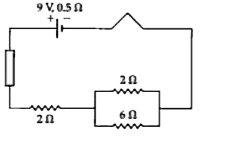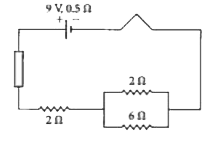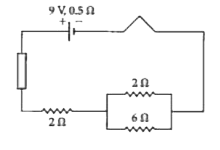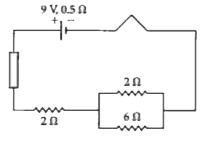Complete Solutions to SECTION-B of chapter SAMPLE QUESTION PAPER 2 of Class 10 book with complete answers and questions
| Class 10 | PHYSICS |
| Chapter | SAMPLE QUESTION PAPER 2 |
| OSWAL | SECTION-B |
| Number Of Questions | 32 |
| Academic Year | 2023-24 |
Show that the sum of kinetic energy and potential energy (ie, total mechanical energy) is always conserved in the case of a freely falling body under gravity (with air resistance neglected from a height by finding it when (i) the body is at the top c) the body has fallen a distance in the body has reached the ground.
06:28View SolutionA uniform metre rod is balanced at the 70 cm mark by suspending a weight of 50 gf at the 40 cm mark and 200 gf at the 95 cm mark. Draw a diagram of the arrangement and calculate the weight of the metre rod.
02:35View SolutionDraw a diagram of a pulley system of velocity ratio 4. Calculate its mechanical advantage efficiency is 90%.
01:36View SolutionWhat is understood by lateral displacement? State two factors on which it depends.
02:24View SolutionAn object is kept at a distance of 15 cm from a convex lens of focal length 10 cm. Calculate the image distance and state the characteristics of the image formed.
03:29View SolutionWrite two properties common to all the electromagnetic radiations.
03:46View SolutionName two sources, each of infrared radiations and ultraviolet radiations.
01:27View SolutionA vibrating tuning fork is placed over the mouth of a burette filled with water. The tap of the burette is opened and the water level gradually starts falling. It is found that the sound from the tuning fork becomes very loud for a particular length of the water column.
Why does the sound become very loud for this lenght of the water column?01:12View SolutionA vibrating tuning fork is placed over the mouth of a burette filled with water. The tap of the burette is opened and the water level gradually starts falling. It is found that the sound from the tuning fork becomes very loud for a particular length of the water column.
Why does the sound become very loud for this lenght of the water column?01:12View SolutionDefine the power of a lens.
01:21View SolutionA child is using a spectacle with power of -2.5 D. What is meant by the negative sign?
01:30View SolutionFind the focal length of the lens used.
View SolutionA man standing in front of a wall produces a sound and hears an echo after 3 s. He walks .X. m away from the wall and produces the same sound. Now he hears an echo after 5.25 s. Calculate distance he walked away from the wall. (Speed of sound in air is 340 m/s)
04:19View SolutionWhat characteristics should a fuse wire have?
01:18View SolutionName two factors on which the internal resistance of a cell depends and state how does it depend on the factors stated by you.
01:53View SolutionIn the circuit diagram given below, a cell of 9 V and internal resistance of `0.5 (Omega)` is connected across a resistor A of `2Omega` in series and two resistors of `2Omega` and `6Omega` in parallel.

Find
The total resistance02:19View SolutionIn the circuit diagram given below, a cell of 9 V and internal resistance of `0.5 (Omega)` is connected across a resistor A of `2Omega` in series and two resistors of `2Omega` and `6Omega` in parallel.

Find
The total current03:18View SolutionIn the circuit diagram given below, a cell of 9 V and internal resistance of `0.5 (Omega)` is connected across a resistor A of `2Omega` in series and two resistors of `2Omega` and `6Omega` in parallel.

Find
The current in the `6Omega` resistor.04:36View SolutionIn the circuit diagram given below, a cell of 9 V and internal resistance of `0.5 (Omega)` is connected across a resistor A of `2Omega` in series and two resistors of `2Omega` and `6Omega` in parallel.

Find
The potential difference across the terminals of the cell.04:09View SolutionDefine latent heat of fusion of ice.
02:01View SolutionWhat happens to the heat supplied to the substance when, the heat supplied causes no change in the temperature of the substance?
01:51View SolutionTwo liquids A and B have specific heat capacities `2.5 Jg^(-1)""^(@)C` and `3.2 Jg^(-1)""^(@)C` respectively.
Which liquid is a good conductor of heat? Why?01:53View SolutionTwo liquids A and B have specific heat capacities `2.5 Jg^(-1) ""^(@)C` and `3.2 Jg^(-1) ""^(@)C` respectively.
Which liquid is more suitable as a liquid in radiators for cooling?02:00View SolutionA calorimeter of mass 60 g contains 180 g of water at `29^(@)C`. Find the final temperature of the mixture, when 37.2 g of ice at -`10^(@)C` is added to it (specific heat capacity of water = `4200 J//kg `K. latent heat of ice `336 xx 10^(3)J//kg`. Specific heat capacity of ice `= 2100 J//kg K`, specific heat capacity of the calorimeter is `0.42 Jg^(-1) xx C^(-1)`)
06:23View SolutionWhat are back ground radiations?
02:09View SolutionWrite an equation of an alpha emission from `U_(92)^(238)`
01:01View SolutionWhat will be the change in the rate of radioactivity if the temperature of the radioactive substance is raised to four times the initial temperature?
01:37View SolutionAn atomic nucleus A is composed of 84 protons and 128 neutrons. The nucleus A emits and alpha particle and is transformed into a nucleus B.
(i) What is the composition of B ?
(ii) The nucleus B emits a beta particle and is transformed into a nucleus C. What is the composition of C?
(iii) What is mass number of the nucleus A ?
(iv) Does the composition of C change if it emits gamma radiations ?03:31View SolutionAn atomic nucleus A is composed of 84 protons and 128 neutrons. The nucleus A emits and alpha particle and is transformed into a nucleus B.
(i) What is the composition of B ?
(ii) The nucleus B emits a beta particle and is transformed into a nucleus C. What is the composition of C?
(iii) What is mass number of the nucleus A ?
(iv) Does the composition of C change if it emits gamma radiations ?03:31View SolutionAn atomic nucleus A is composed of 84 protons and 128 neutrons.
Does the composition of nucleus C change if it emits gamma radiations ?01:10View SolutionExplain the meaning of the statement current rating of a fuse is 5 A..
01:10View SolutionIn the transmission of power, the voltage of power generated at the generating station is stepped up from 11 kV to 132 kV before it is transmitted. Why?
02:01View Solution
SECTION-B questions and complete solutions for chapter SAMPLE QUESTION PAPER 2 of SELINA PHYSICS (ENGLISH) of Class 10
